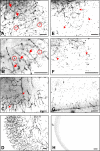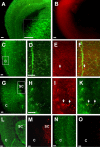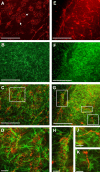Basic fibroblast growth factor modulates density of blood vessels and preserves tight junctions in organotypic cortical cultures of mice: a new in vitro model of the blood-brain barrier
- PMID: 17376986
- PMCID: PMC6672460
- DOI: 10.1523/JNEUROSCI.4033-06.2007
Basic fibroblast growth factor modulates density of blood vessels and preserves tight junctions in organotypic cortical cultures of mice: a new in vitro model of the blood-brain barrier
Abstract
This study was performed to examine the maintenance of blood vessels in vitro in cortical organotypic slice cultures of mice with special emphasis on basic fibroblast growth factor (FGF-2), which is known to promote angiogenesis and to preserve the integrity of the blood-brain barrier. Slices of neonatal day 3 or 4 mouse brain were maintained for 3, 7, or 10 d in vitro (DIV) under standard culture conditions or in the presence of FGF-2. Immunohistochemistry for factor VIII-related antigen or laminin revealed a relative low number of blood vessels under standard conditions. In contrast, moderate FGF-2 concentrations increased the number of vessels: with 0.5 ng/ml FGF-2 it was 1.4-fold higher after DIV 3 or 1.5-fold after DIV 7 compared with controls; with 5 ng/ml it was almost doubled in both cases. With an excess of 50 ng/ml, FGF-2 vessels were reduced after DIV 3 or similar to controls after DIV 7. FGF receptor 1 was preferentially found on endothelial cells; its immunolabeling was reduced in the presence of the ligand. Cell death detected by an ethidium bromide analog or the apoptosis marker caspase-3 was barely detectable during the 10 d culture period. Immunolabeling of the tight junction proteins ZO-1 (zonula occludens protein 1), occludin, claudin-5, and claudin-3 revealed evidence for structural integrity of the blood-brain barrier in the presence of moderate FGF-2 concentrations. In conclusion, FGF-2 maintains blood vessels in vitro and preserves the composition of the tight junction. Hence, we propose FGF-2-treated organotypic cortical slices as a new tool for mechanistic studies of the blood-brain barrier.
Figures






Similar articles
-
Functions of fibroblast growth factor (FGF)-2 and FGF-5 in astroglial differentiation and blood-brain barrier permeability: evidence from mouse mutants.J Neurosci. 2003 Jul 23;23(16):6404-12. doi: 10.1523/JNEUROSCI.23-16-06404.2003. J Neurosci. 2003. PMID: 12878680 Free PMC article.
-
Preservation of transendothelial glucose transporter 1 and P-glycoprotein transporters in a cortical slice culture model of the blood-brain barrier.Neuroscience. 2010 Sep 29;170(1):361-71. doi: 10.1016/j.neuroscience.2010.06.073. Epub 2010 Jul 9. Neuroscience. 2010. PMID: 20603190
-
Immunolocalization of tight junction proteins in blood vessels in human germinal matrix and cortex.Histochem Cell Biol. 2007 Feb;127(2):205-13. doi: 10.1007/s00418-006-0232-z. Epub 2006 Sep 7. Histochem Cell Biol. 2007. PMID: 16957815
-
Transmembrane proteins of the tight junctions at the blood-brain barrier: structural and functional aspects.Semin Cell Dev Biol. 2015 Feb;38:16-25. doi: 10.1016/j.semcdb.2014.11.004. Epub 2014 Nov 26. Semin Cell Dev Biol. 2015. PMID: 25433243 Review.
-
Structural and functional aspects of the blood-brain barrier.Prog Drug Res. 2003;61:39-78. doi: 10.1007/978-3-0348-8049-7_2. Prog Drug Res. 2003. PMID: 14674608 Review. No abstract available.
Cited by
-
Targeting the blood-nerve barrier for the management of immune-mediated peripheral neuropathies.Exp Neurol. 2020 Sep;331:113385. doi: 10.1016/j.expneurol.2020.113385. Epub 2020 Jun 17. Exp Neurol. 2020. PMID: 32562668 Free PMC article. Review.
-
VEGF-A165 potently induces human blood-nerve barrier endothelial cell proliferation, angiogenesis, and wound healing in vitro.Cell Mol Neurobiol. 2013 Aug;33(6):789-801. doi: 10.1007/s10571-013-9946-3. Epub 2013 May 26. Cell Mol Neurobiol. 2013. PMID: 23712256 Free PMC article.
-
An In Vitro Model of the Blood-Brain Barrier for the Investigation and Isolation of the Key Drivers of Barriergenesis.Adv Healthc Mater. 2024 Dec;13(32):e2303777. doi: 10.1002/adhm.202303777. Epub 2024 Aug 5. Adv Healthc Mater. 2024. PMID: 39101628 Free PMC article.
-
Subfield-specific neurovascular remodeling in the entorhino-hippocampal-organotypic slice culture as a response to oxygen-glucose deprivation and excitotoxic cell death.J Cereb Blood Flow Metab. 2013 Apr;33(4):508-18. doi: 10.1038/jcbfm.2012.190. Epub 2012 Dec 12. J Cereb Blood Flow Metab. 2013. PMID: 23232944 Free PMC article.
-
Altered expression of claudin family proteins in Alzheimer's disease and vascular dementia brains.J Cell Mol Med. 2010 May;14(5):1088-100. doi: 10.1111/j.1582-4934.2009.00999.x. J Cell Mol Med. 2010. PMID: 20041969 Free PMC article.
References
-
- Anderson JM, van Itallie CM. Tight junctions and the molecular basis for regulation of paracellular permeability. Am J Physiol. 1995;269:G467–G475. - PubMed
-
- Balda MS, Matter K. Tight junctions. J Cell Sci. 1998;111:541–547. - PubMed
-
- Brown RC, Mark KS, Egleton RD, Huber JD, Burroughs AR, Davis TP. Protection against hypoxia-induced increase in blood–brain barrier permeability: role of tight junction proteins and NFκB. J Cell Sci. 2003;116:693–700. - PubMed
Publication types
MeSH terms
Substances
LinkOut - more resources
Full Text Sources
Research Materials
